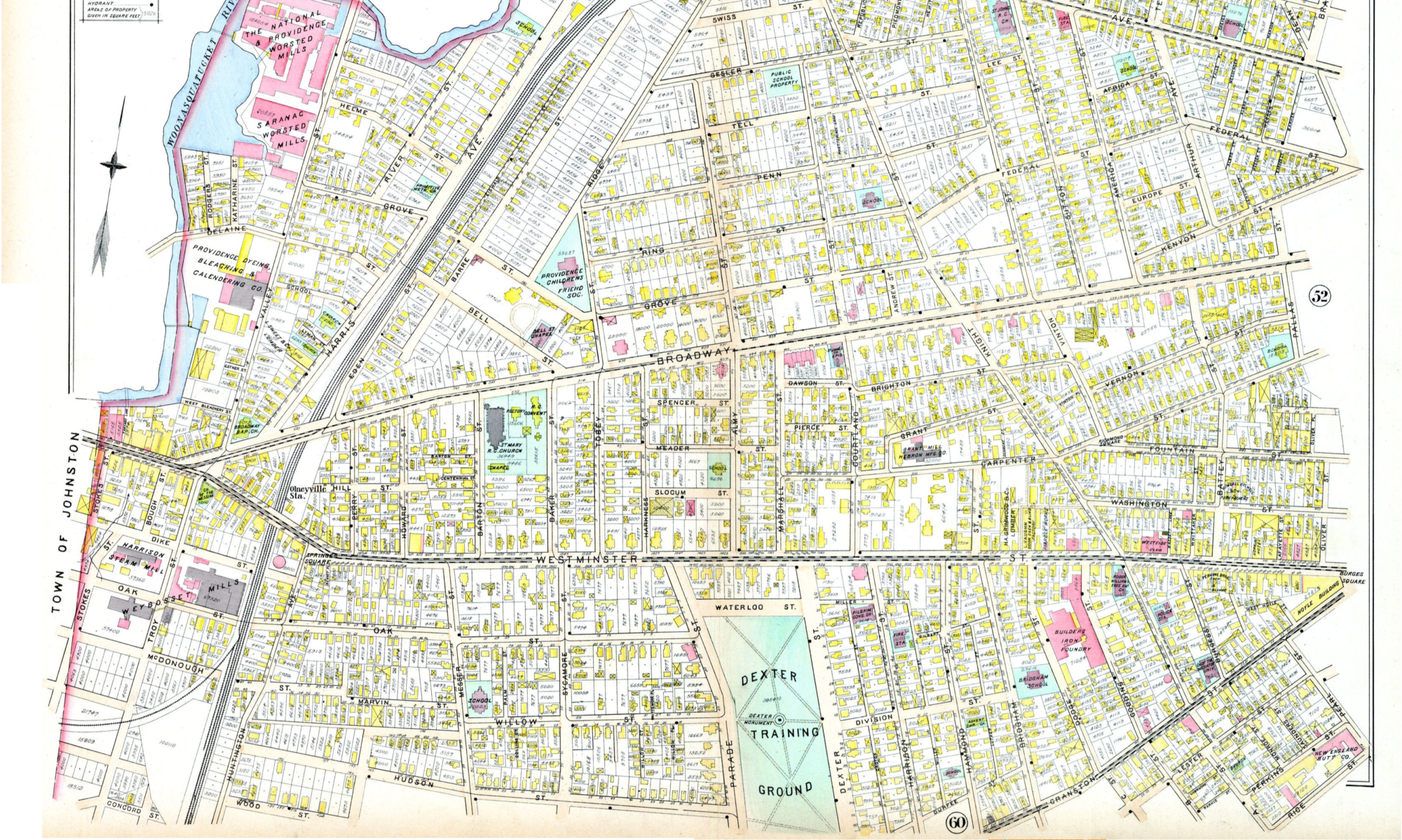This post first appeared on RI Future
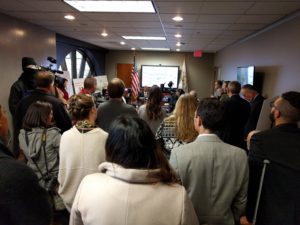 I’ve been talking up a progressive, urban solution for the 6-10 Connector almost as long as James Kennedy has. So I was excited and cautious and skeptical yesterday at the press event revealing the compromise plan for the corridor negotiated between RIDOT and the City of Providence. There were words from Governor Raimondo, Mayor Elorza, Providence Planning & Development Director Bonnie Nickerson, and RIDOT Director Peter Alviti.
I’ve been talking up a progressive, urban solution for the 6-10 Connector almost as long as James Kennedy has. So I was excited and cautious and skeptical yesterday at the press event revealing the compromise plan for the corridor negotiated between RIDOT and the City of Providence. There were words from Governor Raimondo, Mayor Elorza, Providence Planning & Development Director Bonnie Nickerson, and RIDOT Director Peter Alviti.
As it turns out, I left the room more optimistic than I went in. If everything in the plan gets built as laid out yesterday, I will be pretty pleased. Here are some pros and cons as I see them:
Pros
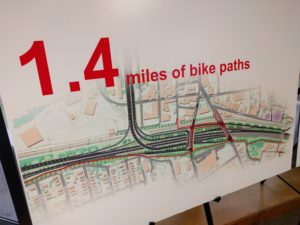
Good bike connections: The connection between the Washington Secondary Bike Path (aka the Cranston Bike Path), the Woonasquatucket River Greenway, and downtown Providence is one of the most critical gaps in the state, and the most logical connection is intimately tied to the 6-10 Connector. It’s great to see both the City and the State hear the public’s plea to make this connection. We need to keep holding their feet to the fire to make sure the connections pledged yesterday get built, and are separate from traffic, but their repeated emphasis of this yesterday was a great sign.
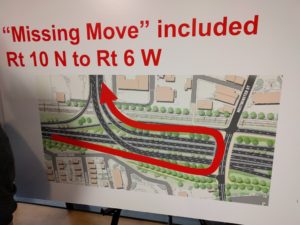 “The Missing Move”: It’s a pretty dumb name, but it’s a really important problem with the existing infrastructure. There’s not currently a way you can stay on the highway and get from 10 North to 6 West. Consequently, most people get off the highway and go through Olneyville Square to get on 6 West on the other side. This plan fixes that. While you might think all that traffic would be good for Olneyville businesses, most of them aren’t stopping, and consequently the opposite is true. All that car traffic squished through the awkward alignment of Olneyville Square makes it not a place people want to spend time, and its local economy suffers. Rebalancing the modal preference in Olneyville Square just slightly toward bike/ped may do wonders for the neighborhood.
“The Missing Move”: It’s a pretty dumb name, but it’s a really important problem with the existing infrastructure. There’s not currently a way you can stay on the highway and get from 10 North to 6 West. Consequently, most people get off the highway and go through Olneyville Square to get on 6 West on the other side. This plan fixes that. While you might think all that traffic would be good for Olneyville businesses, most of them aren’t stopping, and consequently the opposite is true. All that car traffic squished through the awkward alignment of Olneyville Square makes it not a place people want to spend time, and its local economy suffers. Rebalancing the modal preference in Olneyville Square just slightly toward bike/ped may do wonders for the neighborhood.
Tobey Street: The highway onramp at Tobey Street now chokes the Federal Hill neighborhood around it with highway-bound traffic, and the plan calls for replacing the onramp with a local road crossing the highway. There’s even a protected bike lane on Tobey in the plan. While even more bike/ped-scaled crossings of the corridor would have been better, Tobey Street is a big win.
No more flyover shadowing Westminster & Broadway: it was great to hear Director Alviti and others tout the removal of the bird-poop-generating flyover as removing a “physical barrier” from these streets. Today’s flyover really is that, a psychological deterrent from visiting Olneyville Square from its east. The compromise plan does away with the flyover, which will again address residents’ concerns about connectivity.
Connecting Olneyville & Silver Lake: Space is allocated in the plan for new streets connecting the Dyke Street neighborhood of Olneyville under Route 6 to Silver Lake, as well as new development on the south side of the highway. A new street crossing under Route 6 will be built right next to the train tracks as part of this plan, and Agnes Street, another potential crossing, will not be built as part of this project but the City specifically left space in the highway rebuilding to connect Agnes across in the future. The plan also calls for enhancements under Route 6 there to make it more welcoming as a place to be. More connections across = good.
Cons

It’s still a highway: One of the primary entreaties of the Fix the 6-10 Coalition has been “a place, not a highway.” James’s whole vision with the Boulevard idea was for it to not be a highway. The whole point of the City’s initial forum with national experts was that it doesn’t need to be a highway and it shouldn’t be a highway. All the national press the issue has gotten says it shouldn’t be a highway. Well…it’s still a highway. Even with the hard work of the City of Providence to make RIDOT’s plan more urban-friendly, we’re still prioritizing and encouraging suburban auto-dependent travel over our capital city’s neighborhood livability and public health. That sucks. Traffic going through urban places should go through on the terms of the people living in the urban places. The alternative we see here is called spatial injustice and engineers obsessed with upholding the traffic flow of the status quo perpetuate it [Side note: RIDOT has repeatedly used suspect traffic volume figures throughout this whole process: “100,000 vehicles a day, mostly regional not local” without producing the data to back this up. If there’s any chance of reversing this decision, challenging that data is part of it]. Even beyond the public health of neighborhoods abutting the 6-10 Connector and the perpetuation of unsustainable regional travel, maintaining a highway in the corridor screws up the walkability of the Memorial & Francis intersection by Providence Place Mall. Realistically, politically, I’m not optimistic that the paradigm will change on this, but maybe if enough people call the Governor, it can.
Dean Street isn’t until “phase 2”: One of the worst parts about the 6-10 Connector today is Dean Street over the highway. Getting from Atwells Ave to Pleasant Valley Parkway by foot or bike? Fuhgedaboudit. It’s a nightmarish highway bridge with multiple on/off ramps making it extremely unsafe. If yesterday’s plan brings the Washington Secondary Trail connection to fruition, Dean Street will be one of the biggest priorities for bike/ped connections in all of Providence. “Phase 2” can’t come soon enough. Don’t hold your breath, but do call the Governor.
The “Halo” is gone: Totally debatable whether this is a pro or a con. I liked it because it was iconic, but I totally hear people who think it wasn’t an ideal part of the plan. One silver lining is that the iconic rendering that replaced it in the slide decks was the Westminster Street bridge. Here’s to making mundane urban arterials beautiful!
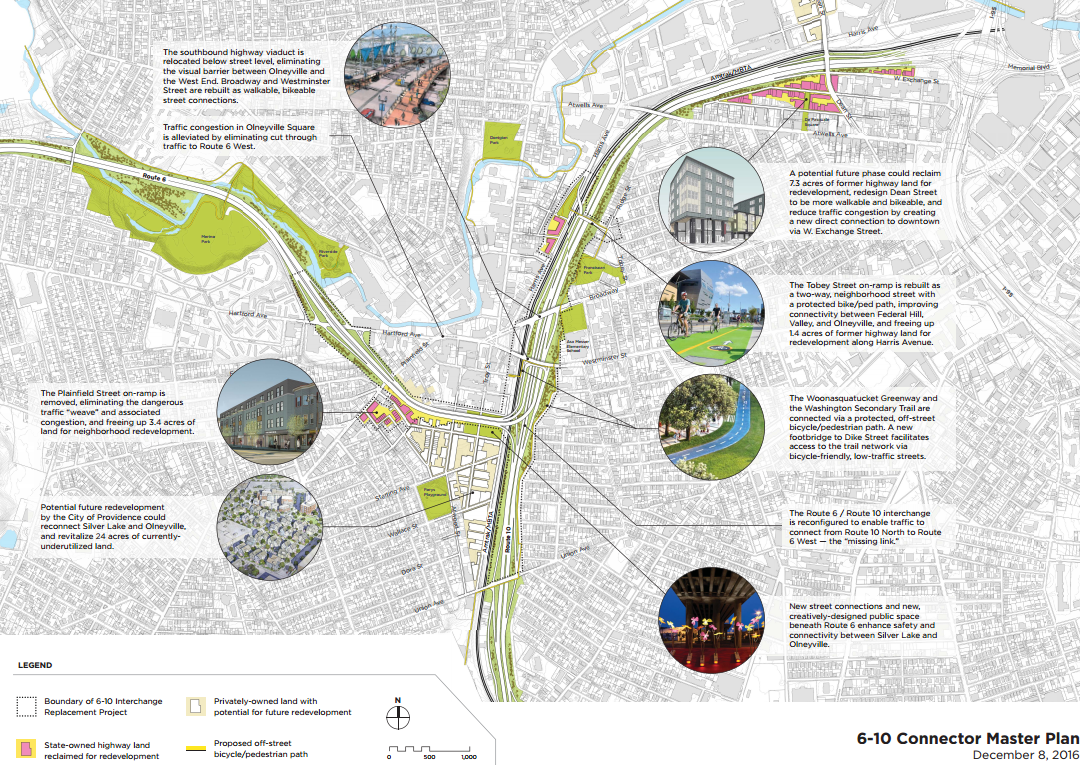
Conclusions
Is this plan perfect? No. Can we pack up and go home on this issue? No; we need to hold the State to all the good things in this plan and push to get the best details we can. But a few things are certain:
- The advocacy of Moving Together PVD & the Fix the 6-10 Coalition absolutely saved us from the as-is rebuild. I’ve heard that repeatedly from multiple sources. Never underestimate the power of bringing together lots of legitimacy-bearing partners around a compelling vision. We should keep this energy going.
- The offices of Governor Raimondo, Mayor Elorza, and Providence Planning & Development all did commendable jobs sculpting this huge project into something better than what it started as. See the Fix the 6-10 Coalition’s statement for more detailed acclamations. Even RIDOT came around somewhat to a plan that’s really pretty decent, and its staff & leadership should be proud of the distance they’ve come on this.
- If there’s one thing we learned from Trump’s election, it’s that complacency is absolutely never warranted. The same is true here. While yesterday was a big milestone in the development of this project, none of us should drop our guard, none of us should unsubscribe from that Google Alert, until the ribbon-cutting starts to fade into memory. That’s why I told every reporter I talked to after yesterday’s meeting that “the devil is in the details” and “I look forward to seeing these plans implemented”. We have to keep holding RIDOT’s feet to the fire, and I look forward to standing arm in arm with you as we do that!
